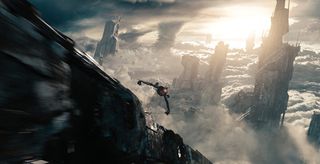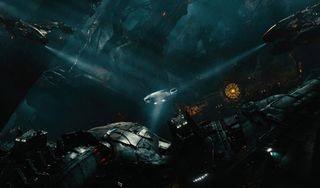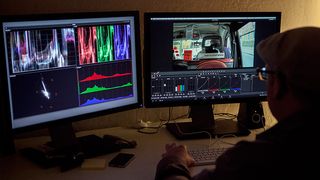Speed up your 3D work with NVIDIA Quadro
VFX and motion design specialists agree that they work faster and avoid frustrating bottlenecks in their workflow thanks to NVIDIA GPU-driven workstations.
There is almost nothing more frustrating than waiting for a 3D scene to render, or worse still for a viewport to update when trying to work in real-time with live feedback.
Part of what makes 3D modelling, texturing and animation such a rewarding process is seeing your artistic endeavours develop before your eyes.
In recent years, the expectations from directors and supervisors has outstripped the abilities of core technologies and, although working with massive datasets is possible, the time needed to see the results of a change can be huge barriers to efficiency as well as creative energy.
Pixmondo
The team at visual effects company, Pixomondo, ran into this very problem while working on the VFX shots for Star Trek Into Darkness. Although the studio has an international team, which can utilise all the rendering power that their worldwide facilities have to offer, they still came up against a technical block, where their older generation workstations could take up to an hour to refresh when using Autodesk’s 3ds Max 3D modelling, animation and rendering software. Even working 24/7 couldn't compensate for the time lost, especially given that the artists involved needed smooth navigation and an interactive workflow to see how their vision actually translated to the screen.

The solution to this bottleneck was to turn from CPU reliance and older, slower, low-powered GPUs to installing Quadro K4000 cards, built on NVIDIA’s latest and fastest Kepler GPU architecture, to their workstations. Pixomondo artists discovered how much faster and smoother data was processed, massively reducing their refresh times, whereas before, getting real time feedback from making even the smallest tweaks to data heavy scenes had been a substantial undertaking.

Being able to process assets much faster and see results closer to the finished product is vital to a 3D artist. The K4000-accelerated workstations enabled them to turn on features that they had previously been unable to run, such as shadows in the viewport and moving light sources around, allowing for more accurate previews of how a scene would take shape, even for those with hundreds of 8K and 16K textures. This meant asset creation using software such as The Foundy MARI could run as it should, with artists seeing the smallest changes, as they work, thanks to a fully responsive, interactive workflow.
Swordfish
It hasn't only been Pixomondo who has felt the benefits of NVIDIA’s Quadro cards either. Swordfish, the San-Francisco-based motion design specialist recently worked on a project that involved using footage filmed using Sony's F55 camera, but the team ran into problems as the Sony RAW MXF codec wasn't supported by the tools used in their usual post-production pipeline. Faced with added pressure to deliver a fast turnaround, they had tried working with DaVinci’s Resolve but previous experience hadn't met their production needs, so this time, decided to run it using NVIDIA Quadro K5000 GPUs.
Get the Creative Bloq Newsletter
Daily design news, reviews, how-tos and more, as picked by the editors.

Upgrading their Mac Pro with dual Quadro K5000 for Mac GPUs, it reduced the waiting time of transcoding RAW MXF files to mere minutes as opposed to hours and they could easily manipulate exposures in Resolve to compensate for any shooting errors.
The results of this cost effective system offers smaller studios the ability to explore new opportunities and expand their services. Leveraging the ability of being able to offer colour correction and other high-end finishing services means more aspects of a project can be kept in-house, boosting a business’s bottom line.
The benefits to artists are clear. To work faster and avoid frustrating bottlenecks in a workflow, NVIDIA GPU-driven workstations are a proven solution.

Thank you for reading 5 articles this month* Join now for unlimited access
Enjoy your first month for just £1 / $1 / €1
*Read 5 free articles per month without a subscription

Join now for unlimited access
Try first month for just £1 / $1 / €1
The Creative Bloq team is made up of a group of design fans, and has changed and evolved since Creative Bloq began back in 2012. The current website team consists of eight full-time members of staff: Editor Georgia Coggan, Deputy Editor Rosie Hilder, Ecommerce Editor Beren Neale, Senior News Editor Daniel Piper, Editor, Digital Art and 3D Ian Dean, Tech Reviews Editor Erlingur Einarsson and Ecommerce Writer Beth Nicholls and Staff Writer Natalie Fear, as well as a roster of freelancers from around the world. The 3D World and ImagineFX magazine teams also pitch in, ensuring that content from 3D World and ImagineFX is represented on Creative Bloq.




